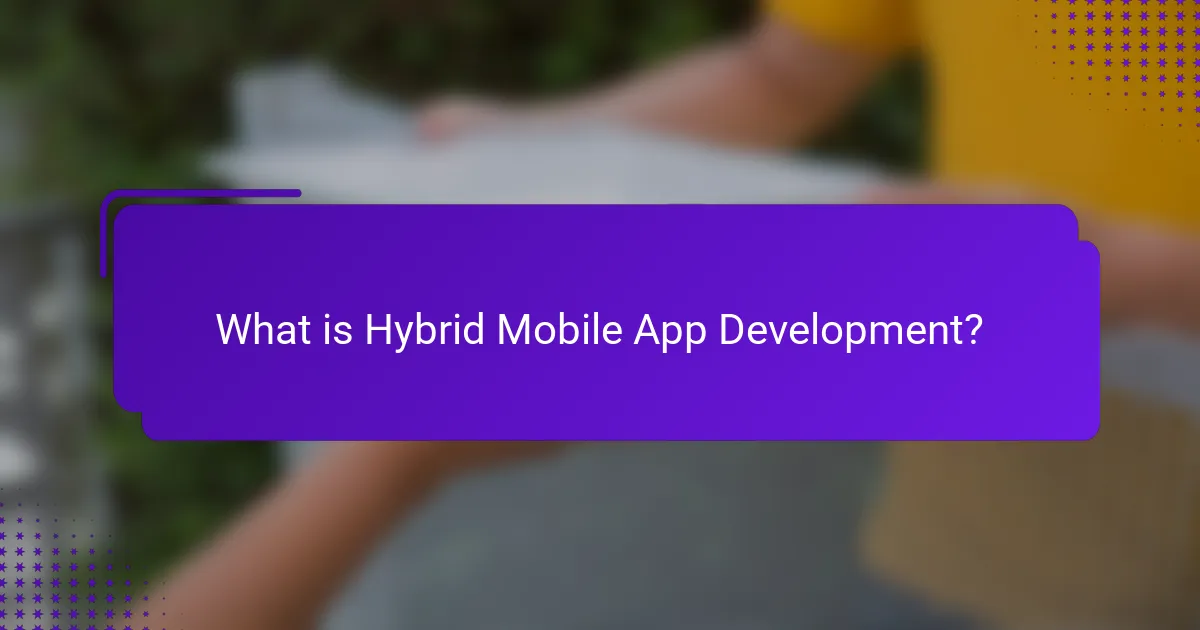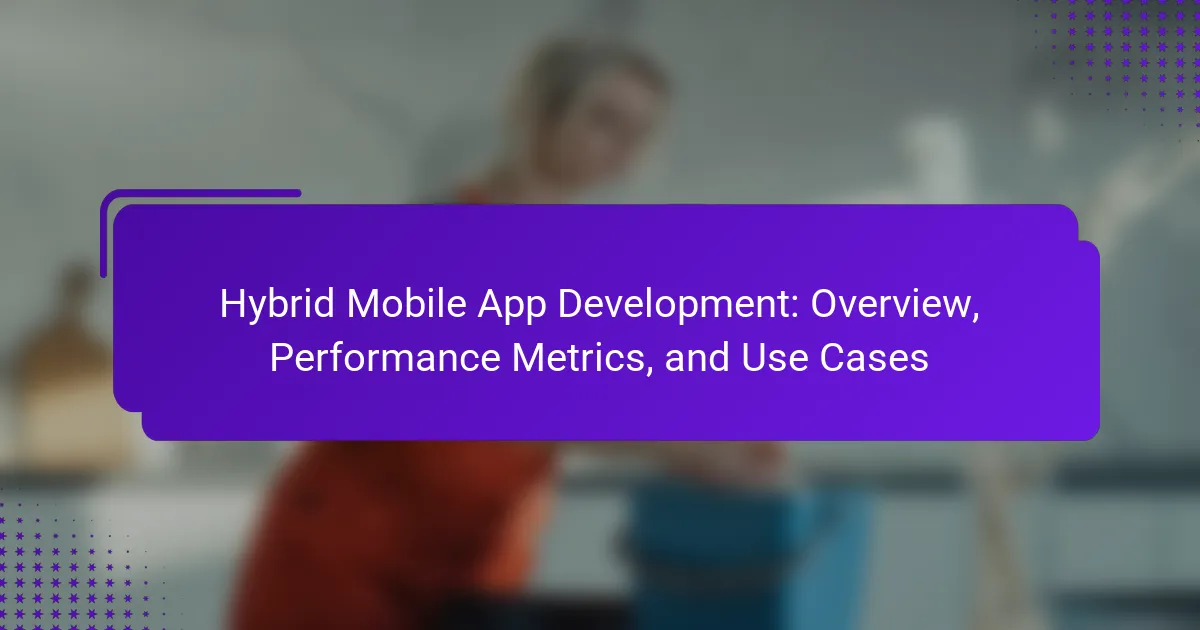Hybrid mobile app development merges native and web application elements, allowing developers to create applications that operate across multiple platforms, including iOS and Android, with a single codebase. This approach utilizes web technologies such as HTML, CSS, and JavaScript, packaged in a native container to access device features and deliver a user experience akin to native apps. The article will examine key performance metrics for hybrid apps, including load time, responsiveness, and crash rate, which are essential for assessing user satisfaction and app stability. Additionally, it will outline various use cases for hybrid mobile app development, highlighting its cost-effectiveness and efficiency in scenarios like MVPs, e-learning, retail, and social networking.

What is Hybrid Mobile App Development?
Hybrid mobile app development is a process that combines elements of both native and web applications. This approach allows developers to create apps that can run on multiple platforms, such as iOS and Android, using a single codebase. Hybrid apps are built using web technologies like HTML, CSS, and JavaScript but are wrapped in a native container. This enables them to access device features and provide a user experience similar to native apps. According to a report by Statista, hybrid app development has gained popularity due to its cost-effectiveness and faster development time compared to building separate native apps for each platform.
How does Hybrid Mobile App Development differ from Native and Web Apps?
Hybrid mobile app development combines elements of both native and web apps. Native apps are built specifically for one platform, using platform-specific languages. They offer high performance and access to device features but require separate codebases for each platform. Web apps, on the other hand, run in browsers and are built using web technologies. They are platform-independent but may lack the performance and features of native apps. Hybrid apps utilize a single codebase to create apps that can run on multiple platforms. This approach allows for faster development and lower costs compared to native apps. Hybrid apps can access device features through plugins, offering a balance between performance and development efficiency.
What technologies are commonly used in Hybrid Mobile App Development?
Common technologies used in Hybrid Mobile App Development include frameworks such as Ionic, React Native, and Flutter. Ionic utilizes web technologies like HTML, CSS, and JavaScript to create cross-platform apps. React Native allows developers to build mobile applications using React, enabling a native look and feel. Flutter, developed by Google, uses the Dart programming language and provides a rich set of pre-designed widgets for a seamless user experience. These frameworks facilitate code sharing across platforms, reducing development time and costs. Additionally, Apache Cordova is often used to access native device features through JavaScript. Each of these technologies has gained popularity due to their efficiency and versatility in hybrid app development.
What are the key components of a typical hybrid app?
A typical hybrid app consists of three key components: a web view, a native wrapper, and backend services. The web view displays web content inside the app. This allows developers to use standard web technologies like HTML, CSS, and JavaScript. The native wrapper provides access to device features such as camera and GPS. It enables the app to function like a native application on various platforms. Backend services support data storage and business logic. These services can be hosted on cloud platforms, ensuring scalability and performance. Overall, these components work together to combine web and native functionalities effectively.
What are the advantages of Hybrid Mobile App Development?
Hybrid mobile app development offers several advantages. It allows for cross-platform compatibility, enabling apps to run on both iOS and Android devices. This approach reduces development time and costs. Developers can use a single codebase for multiple platforms, streamlining updates and maintenance.
Hybrid apps also provide access to device features like GPS and camera, enhancing functionality. They can deliver a near-native user experience while being easier to deploy. According to a report by Statista, hybrid apps can reduce development costs by up to 30%. This makes them a cost-effective solution for businesses.
How does Hybrid Mobile App Development enhance user experience?
Hybrid mobile app development enhances user experience by allowing for cross-platform compatibility. Users can access apps on multiple devices without losing functionality. This approach reduces development time significantly. Faster development leads to quicker updates and improvements. Hybrid apps utilize web technologies, which often result in smoother performance. They can provide a near-native experience while being cost-effective. According to a study by Statista, hybrid apps can reduce development costs by up to 30%. This affordability allows for more frequent user feedback integration. Enhanced user feedback leads to continual improvements in app usability and satisfaction.
What cost benefits does Hybrid Mobile App Development provide?
Hybrid mobile app development reduces costs significantly. It allows developers to create a single codebase for multiple platforms. This eliminates the need for separate teams for iOS and Android. Consequently, development time is shortened, leading to lower labor costs.
Additionally, maintenance costs are lower due to the unified codebase. Updates and bug fixes can be implemented across platforms simultaneously. According to a study by Statista, hybrid apps can reduce development costs by up to 30%. This cost efficiency makes hybrid development an attractive option for businesses.

What are the Performance Metrics for Hybrid Mobile Apps?
Performance metrics for hybrid mobile apps include load time, responsiveness, and crash rate. Load time measures how quickly an app becomes usable. Ideally, it should be under three seconds. Responsiveness evaluates how the app reacts to user inputs. A good hybrid app should have minimal lag. Crash rate tracks the frequency of application failures. A lower crash rate indicates better stability. Other important metrics are memory usage and battery consumption. Memory usage should be optimized to prevent slowdowns. Battery consumption should be minimal to enhance user experience. These metrics collectively determine the overall performance and user satisfaction of hybrid mobile apps.
How do we measure the performance of Hybrid Mobile Apps?
Performance of Hybrid Mobile Apps is measured using various metrics. Key metrics include load time, responsiveness, and user engagement. Load time gauges how quickly the app becomes usable. For example, a load time under three seconds is considered optimal. Responsiveness assesses how well the app reacts to user inputs. High responsiveness leads to better user satisfaction. User engagement metrics track how often users interact with the app. Tools like Google Analytics can provide insights into these metrics. Additionally, crash analytics reveal stability issues. Monitoring these performance indicators helps improve user experience and app efficiency.
What key performance indicators (KPIs) should be tracked?
Key performance indicators (KPIs) for hybrid mobile app development include user engagement, app downloads, and retention rate. User engagement can be measured through metrics like session length and frequency of use. App downloads indicate the initial interest and reach of the app. Retention rate assesses how well the app keeps users over time. Other important KPIs are crash rate, which reflects app stability, and average revenue per user (ARPU), indicating monetization effectiveness. Tracking these KPIs helps developers optimize app performance and user satisfaction.
How does app load time affect user retention?
App load time significantly affects user retention. Research shows that 53% of users abandon an app if it takes longer than three seconds to load. Slow load times lead to frustration, causing users to leave and not return. A study by Google found that every additional second of load time decreases user satisfaction by 16%. Fast loading apps create a better user experience. This encourages users to engage more frequently. Improved retention rates are linked to efficient app performance. Therefore, optimizing load times is crucial for retaining users.
What tools are available for testing Hybrid Mobile App performance?
Tools available for testing Hybrid Mobile App performance include Apache JMeter, Appium, and Firebase Test Lab. Apache JMeter is widely used for load testing and performance measurement. It supports various protocols and can simulate multiple users. Appium is an open-source tool for automating mobile applications. It allows for cross-platform testing of hybrid apps. Firebase Test Lab provides cloud-based infrastructure for testing apps on various devices. It offers automated testing and performance metrics. These tools are essential for ensuring optimal performance in hybrid mobile applications.
How can these tools help in optimizing app performance?
These tools can help in optimizing app performance by providing analytics and insights into resource usage. They identify bottlenecks in processing and memory usage. This enables developers to target specific areas for improvement. Tools like profilers and debuggers allow for real-time monitoring of app behavior. They help in detecting inefficient code and memory leaks. Additionally, performance testing tools simulate user interactions to assess responsiveness. By analyzing these metrics, developers can make data-driven decisions. This leads to enhanced user experience and reduced load times.
What are common pitfalls in measuring performance metrics?
Common pitfalls in measuring performance metrics include unclear objectives, inconsistent data collection, and lack of context. Unclear objectives lead to misaligned metrics that do not reflect true performance. Inconsistent data collection methods can result in unreliable comparisons over time. Lack of context means metrics may be misinterpreted without understanding external factors influencing performance. Additionally, focusing solely on quantitative data may overlook qualitative insights. Ignoring user experience can lead to a skewed understanding of app performance. Lastly, failing to regularly review and adjust metrics can render them obsolete. These issues compromise the effectiveness of performance measurement efforts.

What are the Use Cases for Hybrid Mobile App Development?
Hybrid mobile app development is used in various scenarios. Businesses often choose hybrid apps for cross-platform compatibility. This allows a single codebase to run on multiple operating systems. Hybrid apps are cost-effective due to reduced development time. They are ideal for MVPs, enabling quick market entry. Educational institutions use hybrid apps for e-learning platforms. Retailers leverage them for mobile shopping experiences. Additionally, hybrid apps serve social networking needs effectively. They can integrate device features like GPS and camera, enhancing user engagement.
In what industries is Hybrid Mobile App Development most effective?
Hybrid Mobile App Development is most effective in industries such as retail, healthcare, education, and travel. In retail, it enables seamless shopping experiences across platforms. Healthcare benefits from hybrid apps through patient management and telemedicine solutions. The education sector utilizes hybrid apps for e-learning and student engagement. Travel companies leverage hybrid apps for booking and itinerary management. These industries require cross-platform functionality and rapid development, which hybrid mobile apps provide efficiently.
How are hybrid apps utilized in retail and e-commerce?
Hybrid apps are utilized in retail and e-commerce to enhance customer engagement and streamline operations. These apps combine the features of both native and web applications. Retailers use hybrid apps to provide a seamless shopping experience across devices. They enable users to browse products, make purchases, and track orders efficiently. Hybrid apps also support push notifications for promotions and updates. According to a study by Statista, over 50% of online shoppers prefer mobile apps for their convenience. This preference drives retailers to invest in hybrid app development. Hybrid apps also allow for easier updates and maintenance compared to native apps. This adaptability is crucial in the fast-paced retail environment.
What role do hybrid apps play in education and training?
Hybrid apps serve as versatile tools in education and training. They combine web and native app features, allowing for cross-platform functionality. This flexibility enables institutions to reach a wider audience. Hybrid apps facilitate interactive learning experiences through multimedia content. They support various learning styles by incorporating videos, quizzes, and simulations. Additionally, hybrid apps can be updated easily, ensuring that users have access to the latest information. Research indicates that mobile learning increases engagement and retention rates among students. A study by the Mobile Learning Research Group found that 70% of learners prefer mobile apps for educational content.
What are some successful examples of Hybrid Mobile Apps?
Some successful examples of hybrid mobile apps include Instagram, Twitter, and Uber. Instagram utilizes a hybrid framework for its features, allowing for quick updates across platforms. Twitter employs hybrid technology to maintain a consistent user experience on both iOS and Android. Uber’s app combines native and web technologies to optimize performance and functionality. These apps demonstrate the effectiveness of hybrid development in delivering robust user experiences.
What features contribute to the success of these apps?
Successful hybrid mobile apps feature user-friendly interfaces. A well-designed interface enhances user engagement. Performance optimization is crucial for fast load times. Fast apps retain users and improve satisfaction. Cross-platform compatibility allows broader reach. This feature enables apps to function on various devices. Regular updates keep the app relevant and secure. Security features protect user data, building trust. Offline functionality enhances usability in low-connectivity areas. These combined features significantly contribute to the success of hybrid mobile apps.
How do these examples illustrate the benefits of Hybrid Mobile App Development?
Hybrid mobile app development combines web and native app features. This approach allows for cross-platform compatibility and faster development time. For example, apps like Instagram and Airbnb utilize hybrid frameworks. They demonstrate reduced costs and shorter time to market. Hybrid apps also offer a unified user experience across devices. This consistency enhances user satisfaction and engagement. Furthermore, hybrid development allows for easier updates and maintenance. This flexibility contributes to long-term cost efficiency.
What best practices should be followed in Hybrid Mobile App Development?
Use a responsive design approach in hybrid mobile app development. This ensures the app adapts to various screen sizes and orientations. Implement performance optimization techniques to enhance speed and reduce load times. Utilize native components where possible for better user experience. Prioritize cross-platform compatibility to ensure functionality across different devices. Regularly test the app on multiple platforms to identify and fix issues early. Keep the user interface intuitive to facilitate ease of use. Follow security best practices to protect user data and privacy. Use version control systems to manage code changes effectively.
Hybrid mobile app development is a process that integrates elements of both native and web applications, allowing for the creation of apps that function across multiple platforms using a single codebase. This article provides an overview of hybrid mobile app development, detailing its advantages, performance metrics, and various use cases across industries such as retail, healthcare, and education. Key components, commonly used technologies, and best practices for optimizing performance are also discussed, highlighting the cost-effectiveness and efficiency of hybrid app development in delivering user-friendly experiences.
